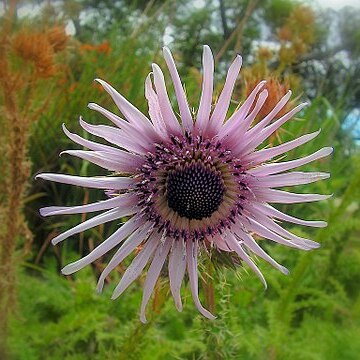A stout perennial herb up to 90 cm tall, stem stout, simple below, branching above into the compound inflorescence, cobwebby or with long soft spreading hairs, winged, leafy. Radical leaves crowded, up to 25 x 10 cm, oblong to broadly elliptic, narrowed to the base, margins sinuate-dentate or shallowly lobed, spiny, harshly pubescent and glandular above, softly white-tomentose below, stem leaves elliptic or lanceolate, much smaller than the basal leaves and diminishing in size upwards, coarsely toothed or lobed, spiny, base decurrent in broad toothed spiny stem wings, harshly pubescent above, cobwebby or not, glandular. Heads 5-8 cm across the expanded rays, several on long (up to 8 cm) bracteate peduncles racemosely arranged. Involucral bracts lanceolate, up to 5 mm broad, tips and margins spiny, minutely glandular and usually cobwebby as well on the backs. Ray and disc flowers concolorous, pale to deep mauve, rarely white. Achenes 3 mm long, turbinate, villous, or glabrous in the sparsely woolly and nearly glabrous forms. Pappus scales up to 1.5 mm long, obovate-oblong, obtuse.
Perennial herb, up to 0.9 m high. Stems stout, winged, spinose. Leaves crowded in basal rosette and densely set along stem; sessile or narrowed somewhat at base; blade of lower leaves oblong to broadly elliptic, 250-450 x 100 mm, margins sinuate-dentate or shallowly lobed, spiny, upper surface harshly pubescent and glandular, softly white-tomentose and glandular below; upper leaves smaller, alternate, sessile, bases decurrent on stem, blade narrowly elliptic to narrowly ovate, margins coarsely lobed, spiny. Heads radiate, 50-80 mm in diameter, racemosely arranged, pedunculate. Involucral bracts connate at base, narrowly ovate, up to 5 mm wide, apex and margins spiny, minutely glandular and cobwebby on backs. Flowers: ray and disc florets pale to deep mauve, rarely white; Jan. Fruit with cypsela turbinate, villous, 2-3 mm long. Pappus scales biseriate, up to 1.5 mm long, obovate-oblong, acute to obtuse.
Perennial herb, 0.3-0.9 m high; stem stout, simple below, branching above into the compound inflorescence, cobwebby or with long soft spreading hairs, leafy. Leaves crowded, oblong to broadly elliptic, narrowed to base, margins sinuate-dentate or shallowly lobed, spiny, harshly pubescent and glandular above; cauline leaves elliptic or lanceolate, coarsely toothed or lobed, spiny, base decurrent, in broad, toothed, spiny, stem wings. Capitula several on peduncles racemosely arranged; involucral bracts lanceolate, apex and margins spiny, minutely glandular. Ray florets yellow. Disc florets pale to deep mauve, rarely white. Flowering time Jan.-Apr. Pappus of obovate-oblong, obtuse scales. Cypselae turbinate, villous, or glabrous.

